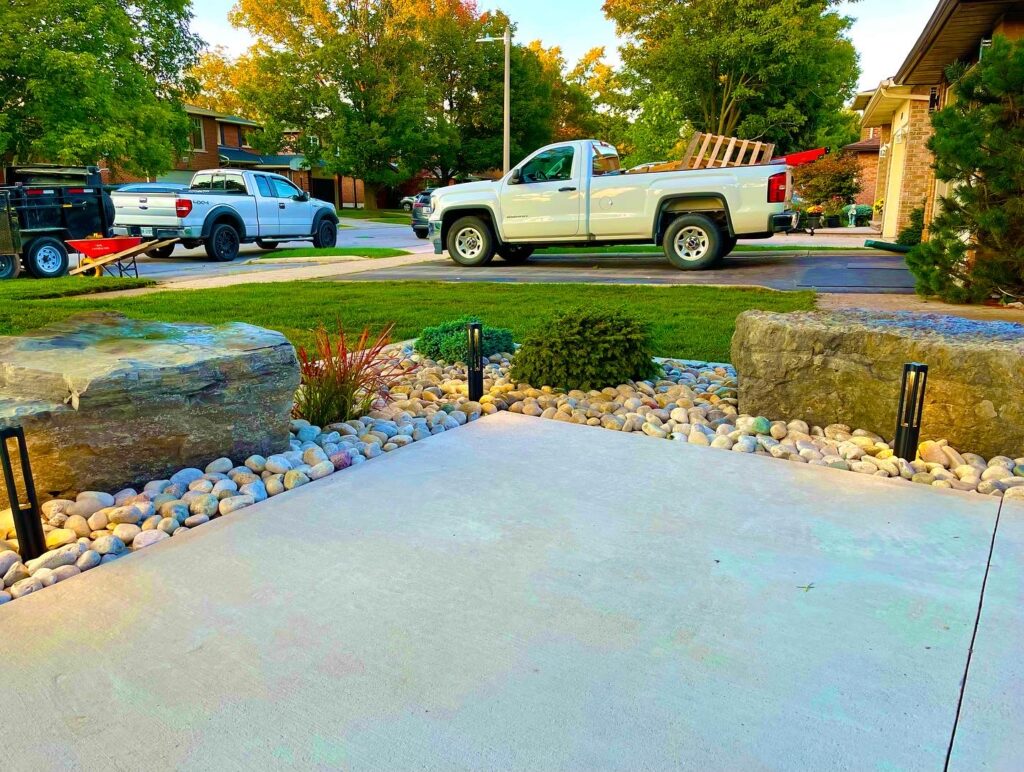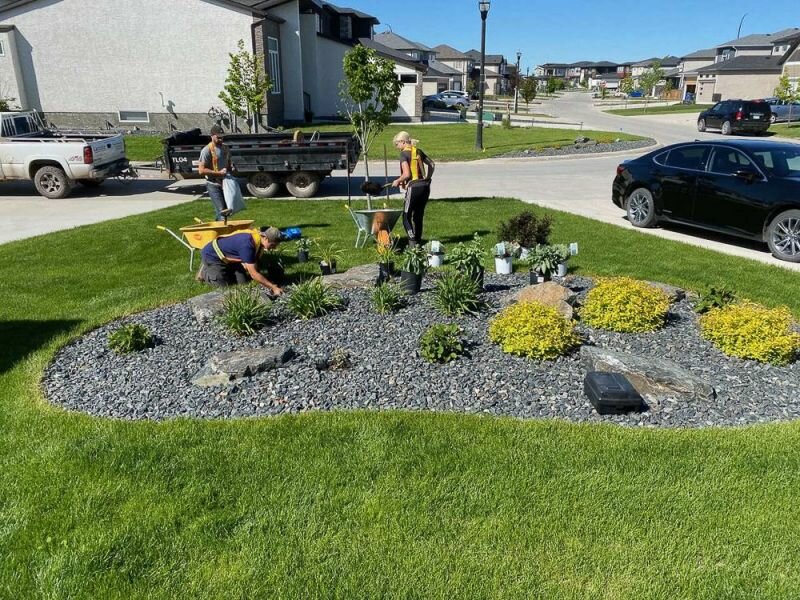Affordable landscaping services to fit your budget and style
Wiki Article
Understanding the Comprehensive Scope of Works in Specialist Landscaping Services
The substantial scope of professional landscape design services encompasses a range of fundamental elements. It includes landscape layout principles, plant option, and hardscaping functions. Additionally, it attends to watering systems and maintenance methods. Each element plays a vital function in developing functional and cosmetically pleasing outside areas. Recognizing just how these components collaborate can disclose much concerning the art and science of landscape design. Nevertheless, the trip into this complex area is simply starting.
Landscape Design Principles
Reliable landscape style concepts are vital for developing harmonious outdoor areas that improve both aesthetic appeal and functionality. These principles assist the arrangement of aspects within the landscape, guaranteeing a cohesive visual experience. Key components include balance, which disperses visual weight equally; percentage, which connects the dimension of different aspects per various other and the area; and unity, which develops a feeling of wholeness with constant themes and products.
Focus directs attention to focal points, while rhythm establishes activity through repeating of style attributes. The reliable use line can develop pathways and guide the eye through the landscape. In addition, recognizing the site's topography, climate, and existing functions is essential for integration with the surrounding environment. By adhering to these foundational concepts, landscape developers can craft areas that not just look enticing yet also offer their designated purpose, boosting the overall experience for individuals.
Plant Selection and Installment
In the domain of professional landscape design, plant option and installation play an essential duty in attaining a thriving garden - landscaping. Stressing indigenous plant advantages, seasonal considerations, and the particular dirt and sunlight requirements of each varieties guarantees a sustainable and cosmetically pleasing landscape. Mindful planning in these areas not just enhances biodiversity yet likewise advertises long-lasting eco-friendly healthIndigenous Plant Benefits
Why should property owners think about indigenous plants for their landscaping projects? Indigenous plants provide various advantages that boost both visual appeals and ecological sustainability. They are well-adapted to neighborhood climates, calling for much less water and maintenance contrasted to non-native types. This resilience reduces the requirement for chemical plant foods and chemicals, promoting a healthier environment. Furthermore, indigenous plants provide habitat and food for regional wild animals, consisting of pollinators, which can raise biodiversity in houses. Their experience with local dirt and climate condition also causes better development prices and durability. By selecting native plants, home owners not just develop visually attractive landscapes yet additionally add to ecological conservation, making a positive influence on their neighborhood environment. Indigenous plants represent a smart choice for landscaping tasks.Seasonal Plant Considerations
Property owners that have actually welcomed indigenous plants in their landscape design can additionally improve their outside spaces by considering seasonal plant selections. By incorporating plants that grow in certain periods, they can create aesthetically enticing and dynamic landscapes throughout the year. Spring might introduce vivid flowers like tulips and daffodils, while summer season can showcase lush vegetation and colorful perennials. Autumn introduces a combination of warm tones with goldenrods and asters, while winter months can be highlighted with evergreens and decorative grasses for texture. Expert landscapers typically suggest picking plants that not just enhance existing indigenous varieties but also offer year-round rate of interest and support regional wildlife. This thoughtful method to seasonal plant option assures a continually developing and sustainable garden environment.Dirt and Sunshine Demands
Effective landscape design rests on recognizing the particular dirt and sunlight needs of plants. Various types grow under varying conditions, calling for a cautious assessment of both factors during the choice procedure (landscaping). Dirt types, such as sandy, clay, or fertile, influence drain, nutrient availability, and origin development. Additionally, pH degrees can impact plant health, demanding dirt screening to identify suitability. Sunlight needs vary considerably; some plants thrive completely sun, while others favor partial or complete shade. A specialist landscaper considers these aspects to guarantee peak development and aesthetic appeal. By lining up plant choices with the setting's certain qualities, landscapes can achieve sustainability, durability, and visual harmony, eventually causing effective plant establishment and lasting maintenanceHardscaping Attributes and Construction
While landscape design typically stimulates pictures of lavish greenery and lively flowers, hardscaping attributes play an essential duty in specifying exterior spaces. These elements, that include outdoor patios, sidewalks, keeping wall surfaces, and decorative stonework, give framework and capability to backyards and gardens. Hardscaping utilizes materials such as concrete, wood, stone, and block, enabling varied designs that complement the natural landscape.The building and construction of hardscaping features needs cautious planning and implementation to guarantee toughness and visual appeal. Professionals assess site problems, water drainage, and spatial partnerships to create cohesive exterior environments. Appropriate setup methods are critical, as they prevent problems like erosion and changing over time.
Integrating hardscaping not only boosts the aesthetic passion of a residential property yet additionally helps with outside activities, making it an essential element of complete landscape design services. Inevitably, thoughtful hardscaping adds to both the capability and elegance of exterior rooms.
Watering Solutions and Water Monitoring
Efficient irrigation systems and water management are vital components of professional landscaping, as they assure that plants obtain the needed hydration for suitable development. These systems can vary from easy drip irrigation arrangements to innovative automatic sprinkler systems, developed to satisfy the particular needs of varied landscapes. Appropriate water management not only enhances water use, lowering waste, yet additionally boosts plant health and wellness and lessens condition threats.Landscaping experts examine numerous aspects, consisting of soil type, plant species, and regional environment, to develop tailored watering options. In addition, including rain harvesting methods can further boost sustainability and effectiveness (Read More). Regular maintenance of watering systems is vital to preserve capability and protect against leaks, which can lead to water loss and increased costs. Ultimately, a well-designed irrigation system plays a critical function in maintaining the visual allure of exterior areas while advertising ecological stewardship within professional landscaping practices
Yard Care and Maintenance Methods
Yard treatment and maintenance methods are essential for attaining a lavish, healthy and balanced backyard that boosts the total landscape. These approaches incorporate numerous techniques targeted at advertising excellent growth and visual allure. Normal mowing is crucial, as it urges thick, also development while stopping weeds from developing. In addition, appropriate fertilization offers necessary nutrients, with applications tailored to the particular lawn kind and soil conditions.Watering techniques should concentrate on deep, occasional watering to encourage root growth, while oygenation improves dirt structure and advertises nutrient absorption. Pest and disease management is likewise crucial; determining problems early permits for effective therapies that lessen damage.
Overseeding can renew slim or damaged grass, improving density and shade. By executing these targeted lawn care strategies, landscape design professionals can ensure that backyards stay healthy and balanced and vivid throughout the seasons, greatly adding to the overall elegance of the residential or commercial property
Seasonal Landscape Treatment and Upkeep
As the seasons adjustment, proper landscape treatment becomes essential for maintaining the health and wellness and beauty of outside rooms. Each period presents special obstacles and demands. In springtime, landscape professionals concentrate on pruning, planting, and feeding to urge growth. Summertime needs regular watering, weed control, and bug monitoring to safeguard recently developed plants.Fall calls for the preparation of gardens for winter season, consisting of mulching, leaf removal, and the growing of light bulbs for the following springtime. In addition, winter months care involves shielding vulnerable plants from frost and guaranteeing that hardscapes are secure and practical.
Throughout the year, seasonal landscape upkeep guarantees that exterior locations continue to be healthy and visually appealing. Expert services can offer tailored maintenance plans that adjust to the details needs of each season, permitting residential property proprietors to enjoy lively landscapes year-round. a fantastic read Overall, seasonal treatment is an essential aspect of professional landscaping that promotes longevity and aesthetic worth.
Lasting Landscape Design Practices
An expanding variety of homeowner are welcoming lasting landscaping practices to create eco-friendly outside areas. These practices focus on conserving sources, improving biodiversity, and lessening environmental impact. Indigenous plants are often picked for their reduced water requirements and compatibility with neighborhood ecological communities, minimizing the demand for chemical plant foods and pesticides. Rainfall gardens and permeable paving are used to take care of stormwater overflow, promoting groundwater recharge and lowering disintegration.Additionally, lasting landscaping includes natural horticulture strategies that focus on dirt wellness and advertise natural bug control. Efficient watering systems, such as drip irrigation and rainwater harvesting, aid maximize water use. Furthermore, landscape designers increasingly advocate for the use of recycled materials, such as recovered timber and stones, to decrease waste. By embracing these lasting practices, home owners not only add to ecological preservation yet additionally produce cosmetically pleasing environments that can prosper with marginal maintenance.
Often Asked Questions
How much time Does a Landscape Design Project Commonly Require To Full?
Generally, a landscaping job can take anywhere from a couple of days to numerous weeks to complete, depending upon the job's complexity, style, and dimension demands. Read More. Aspects such as weather condition and resource availability additionally affect timelinesWhat Variables Impact the Expense of Landscaping Services?
Numerous aspects influence landscaping solution expenses, including job dimension, layout intricacy, material quality, labor expenditures, geographic place, and seasonal demand. Each aspect adds distinctively to the overall economic requirements of a landscape design job.Are Landscape Design Solutions Available Year-Round?
Landscaping services are normally offered year-round, although schedule may vary based upon area, seasonal weather, and specific solution offerings. Some services could be restricted during severe weather condition or off-peak periods.Do Landscape Design Firms Offer Warranties on Their Work?

Can I Style My Landscape Without Specialist Help?
Yes, individuals can create their landscapes without professional assistance. However, they may lack experience in plant selection, design, and environmental factors to consider, possibly leading to less efficient styles that can require expensive modifications later on.
Report this wiki page